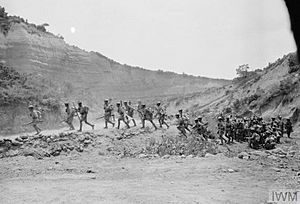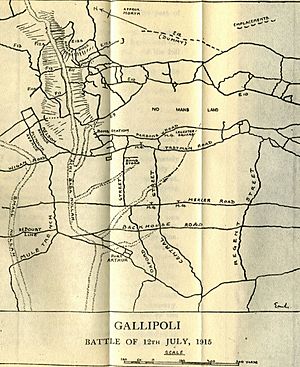Battle of Gully Ravine facts for kids
Quick facts for kids Battle of Gully Ravine |
|||||||
|---|---|---|---|---|---|---|---|
| Part of Gallipoli Campaign | |||||||
 Gurkhas of the 29th Indian Brigade charge through Gully Ravine |
|||||||
|
|||||||
| Belligerents | |||||||
| Commanders and leaders | |||||||
| Strength | |||||||
| Unknown | 13,000 | ||||||
| Casualties and losses | |||||||
| 3,800 | 6,000 | ||||||
The Battle of Gully Ravine was a major battle during World War I. It took place at Cape Helles on the Gallipoli peninsula in June and July 1915. By this time, the Allies (like Britain and France) realized that winning quickly against the Ottoman Empire would be very difficult.
This battle was similar to the trench warfare seen on the Western Front, where soldiers fought from long, narrow ditches. Unlike some earlier attacks, the Battle of Gully Ravine helped the Allies reach their goals, but it came with a very high cost in lives.
Contents
Preparing for Battle: Gully Ravine Attack
Before this battle, on June 4, another fight called the Third Battle of Krithia had made some progress. But it failed on the left side, near Gully Spur and Gully Ravine. To fix this, the Allied commander at Helles, Lieutenant General Aylmer Hunter-Weston, planned new, smaller attacks. These attacks aimed to push forward on the sides of the battle line.
One of these attacks happened on June 21. French troops, with strong artillery support (big guns), attacked Ottoman defenses. They captured one important position. This small win was a big cause for celebration among the Allies, who needed good news.
On June 28, a similar attack was planned for the left side. This area, around Gully Ravine, was very rough and wild. The plan was for the British 29th Division and the 29th Indian Brigade to attack along Gully Spur and the ravine. Another group, the 156th (Scottish Rifles) Brigade, would attack along Fir Tree Spur.
The Main Attack Begins
After two days of heavy bombing from big guns, the battle started on June 28 at 10:45 AM. First, a small raid captured a key Ottoman position. Then, the main attack began.
The artillery fire on Gully Spur was very strong. Soldiers from the 2/10th Gurkha Rifles and the 2nd Battalion of the Royal Fusiliers quickly moved forward about half a mile. They reached a spot called "Fusilier Bluff," which became the furthest north the Allies would get at Helles.
Inside the ravine, the 1st Battalion, Border Regiment, didn't advance as far. The Ottoman soldiers there had some cover from the bombs. Their final position was made stronger with rocks and became known as "Border Barricade."
On the right side of the attack, along Fir Tree Spur, things did not go well for the British. The soldiers of the 156th Brigade were new to fighting and didn't have enough artillery support. They faced strong Ottoman machine gun fire and bayonet attacks, suffering heavy losses. Even so, they were ordered to keep attacking. By the time the attack stopped, the Brigade had lost half its soldiers, with about 800 killed. Some groups had so few soldiers left that they had to combine.
Fierce Counter-Attacks
Ottoman commanders were very worried about the Allied advance. It threatened to surround their right side. Gully Ravine became the scene of intense and fierce fighting as the Ottomans launched many counter-attacks, especially on the night of July 1–2.
Two brave soldiers, Captain Gerald Robert O'Sullivan and Corporal James Somers, from the 1st Battalion, the Royal Inniskilling Fusiliers, earned the Victoria Cross (a very high award for bravery). They recaptured a trench that the Ottomans had taken during a counter-attack.
Faik Paşa, an Ottoman commander known for his bravery, was put in charge of the Ottoman forces in this area. The Ottomans had many soldiers ready to fight, but they didn't have many big guns or machine guns. They kept launching counter-attacks, with the strongest one on July 5. However, all these attacks were pushed back by the Allies.
Still, the Ottomans managed to keep control of the important hills overlooking the area. The Ottoman forces suffered huge losses between June 28 and July 5, with estimates ranging from 14,000 to 16,000 casualties. This was about four times the number of British losses. The British did not agree to a truce to bury the dead, believing that the many fallen soldiers made it harder for the Ottoman troops to attack. This decision angered the Ottomans.
Faik Paşa briefly stopped a counter-attack on June 30 to let his tired troops rest. But other commanders pushed him to continue. On July 2, another big Ottoman counter-attack began. Soldiers faced heavy machine gun fire and suffered terrible losses. The attack continued all night. Eventually, Faik Paşa ordered them to dig in and defend their positions. Because of this, he was replaced by Mehmet Ali Paşa.
The Allies watched these preparations from the air and got ready. On July 5, the last major Ottoman attack of this battle happened. It met a strong wall of fire from the Allies, and many more Ottoman soldiers fell. Finally, the heavy fighting was stopped. This was one of the bloodiest parts of the entire Gallipoli campaign.
After these counter-attacks ended, the battle lines became stable. They stayed mostly the same for the rest of the Gallipoli campaign. Both sides also dug many tunnels and mines under the ground around the ravine.
Achi Baba Nullah Attack
General Hunter-Weston planned one last major attack at Helles for July 12. This attack focused on the center of the line, along a place called Achi Baba Nullah. It was hoped that the Ottoman soldiers would have low morale after their heavy losses.
The plan was for two different brigades to attack at different times, so all the big guns could focus their fire on one brigade at a time. The first brigade attacked in the morning, and the second in the afternoon. The bombing began early, with support from land, sea, and even 14 Allied planes. This was one of the first times planes were used in such a combined attack in military history.
Both attacks started well, with the capture of the first Ottoman trench. However, things soon became confusing. As in earlier battles, the troops advanced too far, lost contact with each other, and came under heavy fire. The next morning, confusion led to a messy retreat. The line was eventually made stable again.
By the end of this battle, one-third of the 52nd Division had become casualties. General Egerton, their commander, was temporarily removed from his position because he protested how his troops were treated.
What Happened Next
In late June, General Hunter-Weston left his command of the British VIII Corps due to illness. This marked the end of Helles as the main fighting area at Gallipoli. The British did not launch any more major attacks there for the rest of the campaign.
The fighting then moved to other areas, like the Sari Bair range and a new landing at Suvla. In August, a smaller attack was made at Helles to distract the enemy, leading to more fighting around Krithia Vineyard. Finally, Helles was completely left by the Allies on January 8, 1916.



